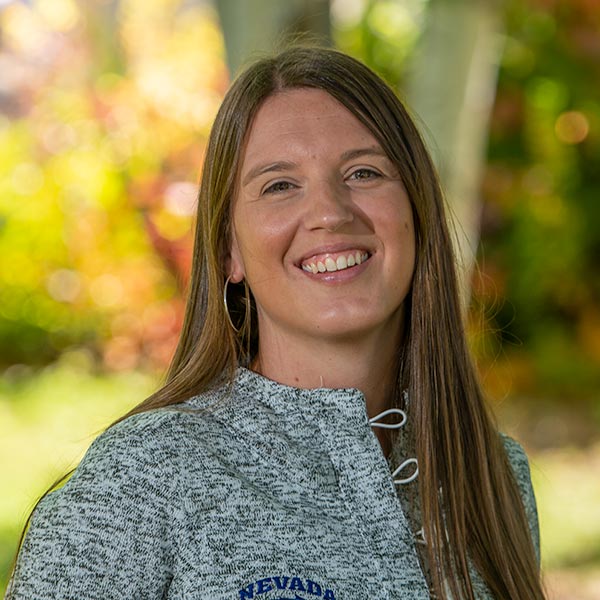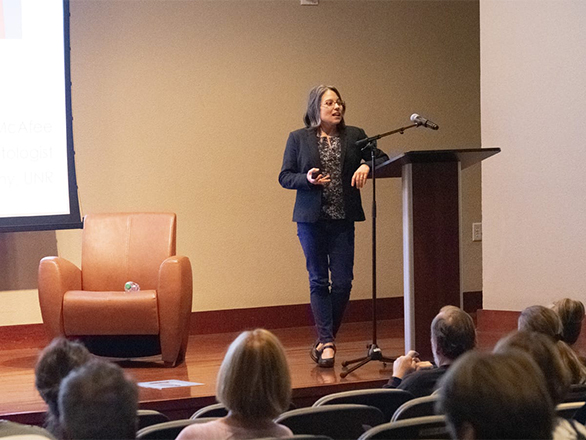Preserving our natural resources
University ecologists help firefighters protect Nevada's lands
![]() The inaugural offering of the College's new Rangeland Ecology & Management Program course for wildland firefighters culminated with a trip to the Pine Nut Mountains. There, students worked in groups to critique and improve upon the management of the area.
The inaugural offering of the College's new Rangeland Ecology & Management Program course for wildland firefighters culminated with a trip to the Pine Nut Mountains. There, students worked in groups to critique and improve upon the management of the area.
 Tamzen Stringham
Tamzen Stringham![]() Story by Ashley Andrews
Story by Ashley Andrews
Wildfires have unleashed devastating losses on Nevada ranches, grazing areas, and habitat for wildlife and recreation. Knowing how to care for Nevada's land before and after it is affected by fire and other disturbances is key to reducing wildland fire risk and repairing lands post-fire. This is where Tamzen Stringham and Devon Snyder, and the land managers they teach come in.
Stringham is a professor and Snyder is an ecologist in the College. With support from its Experiment Station, Stringham leads and Snyder works in the College's Rangeland Ecology Lab.
In collaboration with the U.S. Department of Interior Bureau of Land Management Nevada, Stringham and Snyder developed in 2019 the first training course for wildland firefighters who work on dry lands. Through the training, called the Rangeland Ecology & Management Program, Stringham and Snyder are instilling the decades of rangeland ecology research their lab has conducted and distilled into Nevada's land managers.
Wild horses: Another burning issue for Nevada land managers
The number of wild horses living on public lands in the arid west is too high for the health of those lands, and consequently, the health of the horses as well. The herds are growing so fast that management strategies, such as adoptions, contraception and gathers and removals, are inadequate. This also endangers other wildlife on those lands, as well as the economic benefits of public lands, including livestock grazing and recreation.
In 2019, Stringham started a new project designed to help land managers balance wild horses and other land uses, including native wildlife, livestock and recreation. In the project, she's creating models for monitoring and managing habitat using satellite imagery, an 18-year data archive, and knowledge of how ecological sites respond to disturbances.
This includes the pair's state-and-transition models. The models describe how different combinations of plants and soil respond to events like fire, grazing, soil disturbances and invasive plants. The models also describe, when recovery is possible, pathways to help restore lands.
The training is much needed by Nevada's lands and its workforce. It helps the Bureau's employees meet enhanced educational requirements for fire program management specialists. Without the specialists, it would be hard to reduce Nevada rangeland's likelihood of ignition and, should a fire start, to ensure adequate firefighting resources and leadership to minimize damage.
University-trained firefighter volunteers to help Australia
"They called us down to help ease the fire front as it's hitting thousands of people driving on the highway. So, we were directing air tankers and showing them where to drop so people could get out of there and get out of being trapped in their vehicles." -Rangeland Ecology & Management Program student and Bureau of Land Management Nevada firefighter Matt Petersen
Fulfilling our University's land-grant mission
"What's better to teach Nevada land issues than University of Nevada, Reno. It already has a large knowledge base of Great Basin and Nevada issues, climatology and range types. And it's a great opportunity to partner with a land-grant college. We're a land management agency." -Bureau of Land Management Nevada State Fire Management Officer Paul Petersen
Extension’s Living With Fire Program helps residents prepare family and property
![]() Extension’s Living With Fire Program presented "Five Ways to Prepare Your Family and Property for Wildfire." The Sept. 1, 2020, virtual session covered insurance and wildfire. Photo courtesy of the Living With Fire Program.
Extension’s Living With Fire Program presented "Five Ways to Prepare Your Family and Property for Wildfire." The Sept. 1, 2020, virtual session covered insurance and wildfire. Photo courtesy of the Living With Fire Program.
![]() Story by Tiffany Kozsan
Story by Tiffany Kozsan
Christina Restaino, a fire ecologist, joined the College in 2019. She and her Living With Fire Program team presented several educational offerings in 2020 to help Nevadans reduce the wildfire risk.
The program presented an online speaker series during Nevada Wildfire Awareness Month in May. The "Living With Fire Conversations" sessions included:
- How to prepare for a power outage
- Fire restriction orders on federal lands in Nevada
- Defensible space and reducing the wildfire hazard
- The fire weather outlook and red flag warnings
- Removing noxious and nuisance weeds
Then, in response to a drier than normal winter and a wild wildfire season, and as part of National Preparedness Month in September, the program presented the virtual workshop series, "Five Ways to Prepare Your Family and Property for Wildfire."
"Wildfire is a part of our everyday life now, it seems," Restaino said. "Nevadans, like others around the world, need to be proactive to help protect themselves and their homes."
 Christina Restaino
Christina Restaino
Session topics included:
Session 1
Nevada Insurance Division's Perspective on the Insurance Industry and Wildfire
Session 2
Animal Services & Disaster Preparedness
Session 3
Be Red Cross Ready
Session 4
5 Steps to Creating Effective Defensible Space
Session 5
Retrofitting Your Home to Increase Wildfire Survival
The program also presented the Nevada Network of Fire Adapted Communities Summit in December 2020, in partnership with Nevada Division of Forestry’s Fire Adapted Communities. The theme was "Creating the Toolbox for a Fire Adapted Nevada."
Finally, in 2020 the program launched a brand new website to help homeowners, families and communities get prepared, informed and involved. The site has many different resources and steps homeowners can take during shelter-at-home restrictions.
Preparing Nevadans for wildfire
"It's easy to get overwhelmed when thinking about all the different ways to prepare for wildfire. We aim to help residents understand simple steps they can take to get their family, home and property more prepared for fire." -Extension Natural Resources Specialist Christina Restaino
Scientists keep watch on climate and weather as drought grips Nevada
![]() The Lahontan Reservoir is fed by the Carson River and by the Truckee River with water diversions from the Derby Dam, supplying water for irrigation. Pictured here in 2014, in the third year of a four-year drought, much of the lake was completely dry.
The Lahontan Reservoir is fed by the Carson River and by the Truckee River with water diversions from the Derby Dam, supplying water for irrigation. Pictured here in 2014, in the third year of a four-year drought, much of the lake was completely dry.
 Kerri Jean Ormerod
Kerri Jean Ormerod![]() Story by Mike Wolderbeek
Story by Mike Wolderbeek
Nevada ranchers, water providers and public land managers rely on the U.S. Drought Monitor to keep track of climate and weather. The drought monitor also triggers relief programs that can help agriculture-related businesses in Nevada.
"The Drought Monitor isn’t a simply a map; it's the best assessment of where there is drought, and the severity of drought," Kerri Jean Ormerod, who leads Extension’s Living with Drought program, said. "Volunteer-submitted information helps to complement more traditional metrics and can bridge some of the data gaps across the state."
Ormerod conducts research and education on water, climate and drought hazards for Extension and is an assistant professor of geography with the University's College of Science. Besides helping meteorologists and others better prepare for and respond to Nevada's confusing weather, she hopes to help various groups, such as farmers, ranchers, emergency management personnel and research scientists, to make better-informed decisions.
"If we can collect more data on our precipitation and weather, and analyze and explain it, it can serve several purposes," Ormerod said. "As the driest state in the nation, it is especially important to report zeros, or the lack of precipitation. This is critical information necessary to track and respond to drought."
She said they are recruiting volunteer observers from "anywhere and everywhere" across the state through either the Community Collaborative Rain, Hail and Snow Network or a related citizen science platform designed for drought monitoring.
Ormerod said, "My message to potential weather observers: you can help, get involved – we need you."
Water research addresses water managers’ information needs
Of the many forward-looking climate initiatives of which Extension is a part, perhaps the most comprehensive effort has been the recent Water for the Seasons five-year collaborative research and outreach program. Based in the Truckee-Carson River System, Extension designed and coordinated an interdisciplinary research approach that included hydrologists, engineers and resource economists working with stakeholders representing diverse and competing municipal, industrial, agricultural, environmental and regulatory water management organizations from the system’s headwaters to its terminus.
"Demand is diverse for water – and includes sustaining wildlife and wildlife habitat, irrigated agriculture, growing municipal populations and economic development initiatives," Loretta Singletary, an interdisciplinary outreach liaison and economist with Extension, said. "Water for the Seasons sought to find solutions to variable water supply in a changing climate."
The research team developed 10 key takeaways, including that:
- climate projections across the river system generally show warmer temperatures and increased water supply variability;
- measurable snowpack changes affect the timing and availability of water supply;
- cycles of wet and dry years are important for evaluating future basin water supply and reservoir operation;
allowing for storing water earlier in the year could enhance water supply; - aquifer recharge can mitigate long-term impacts;
- and there is a need for additional collaborative research.
Ormerod's Living with Drought website provides a one-stop-shop for homeowners, gardeners, farmers, ranchers, natural resource managers and others to find information they need, including current drought status information; data and tools that can be used to track and report drought impacts; and information about the basic types and causes of drought.

RELATED STORY | Communicating [drought] science in a divided society
Stephanie McAfee, climatologist and associate professor with the College, discussed issues that come with communicating scientific findings related to drought at the launch of the University's Hitchcock Project, part of the Reynolds School of Journalism. McAfee shared insights about the challenges in a presentation of her work, followed by a Q&A from the audience.
At the event, McAffee said, "There have been no times in the past where there weren't natural disasters. We can point to events and say it's really bad this year and study the information, but studies take a long time to complete."
Partnering with Nevadans to research climate and drought
"We are always looking to increase climate monitoring and research. There aren’t a lot of weather stations. There’s a paucity of data – so not a lot of information to work from to say it's a drought, and not a lot of data to inform decisions. Nevada has a problematic landscape. It's hard to do remote sensing and gather data, so we facilitate partnerships at the federal, state and local level, and down to the ground for reports, to characterize the climate outlooks." -Extension Drought Specialist Kerri Jean Ormerod
Celebrating 25 years of research
Center for Urban Water Conservation invites public to tours, demonstrations, plant and produce sales.
Prediction tool shows how forest thinning may increase Sierra Nevada snowpack
![]() University students perform maintenance on data-collection equipment to help with projects to maintain the Sierra Nevada forest. Photo by Adrian Harpold.
University students perform maintenance on data-collection equipment to help with projects to maintain the Sierra Nevada forest. Photo by Adrian Harpold.
![]() Story by Tiffany Kozsan
Story by Tiffany Kozsan
The forest of the Sierra Nevada mountains is an important resource for the surrounding communities in Nevada and California. Thinning the forest by removing trees by hand or using heavy machinery is one of the few tools available to manage forests. However, finding the best way to thin forests by removing select trees to maximize the forest’s benefits for water quantity, water quality, wildfire risk and wildlife habitat remains a challenge for resource managers. The U.S. Forest Service is leading an effort to balance all these challenges in landscape-scale forest restoration planning as part of the Lake Tahoe West Restoration Partnership.
As part of this effort, the College's Adrian Harpold recently led a team in developing a modeling tool to focus on the issue of water quantity. The tool predicts how different approaches to thinning the forest impact snowpack accumulation in Lake Tahoe, which controls how much water is available for downstream communities such as Reno.
"The snowpack we’ve relied upon is under pressure from years of fire suppression that increased tree density, combined with the effects of climate change and warming temperatures," Harpold, a natural resources & environmental science assistant professor, said.
 Adrian Harpold
Adrian Harpold
He explained that too many trees means less snow reaches the ground. In addition, when many trees are clumped together, they warm up and release heat, which can melt the snow on the ground. However, too few trees means the snowpack is less protected from the sun and wind, which also melt snow.
The tool, developed with funding from our College’s Experiment Station and the U.S. Forest Service, was built to specifically model the west shore of Lake Tahoe, which the team felt was a good sample of the Sierra Nevada forest. The team initially created a small-scale high-resolution model using data collected with 3D laser scanners, called "LiDAR."
Developing realistic solutions for resource managers
"The LiDAR data lets us see individual trees, which we use to 'virtually thin' the forest by taking trees out of the model. As such, it lets us create a thinning experiment that’s realistic." -Assistant Professor Adrian Harpold
Plant tissue engineering improves drought and salinity tolerance
![]() Thale Cress engineered to behave like a succulent, improving water-use efficiency and drought tolerance.
Thale Cress engineered to behave like a succulent, improving water-use efficiency and drought tolerance.
![]() Story by Mike Wolterbeek
Story by Mike Wolterbeek
After several years of experimentation, scientists have engineered thale cress, or Arabidopsis thaliana, to behave like a succulent, improving water-use efficiency, salinity tolerance and reducing the effects of drought. The tissue succulence engineering method devised for this small flowering plant can be used in other plants to improve drought and salinity tolerance with the goal of moving this approach into food and bioenergy crops.
Biochemistry & Molecular Biology Professor John Cushman published in 2020 a paper on his research team's breakthrough. The team included Biochemistry & Molecular Biology Assistant Professor Won Cheol Yim.
The work will be combined with another of Cushman’s projects: engineering another trait called crassulacean acid metabolism (CAM), a water-conserving mode of photosynthesis that can be applied to plants to improve water-use efficiency.
With demand for agricultural products expected to increase by as much as 70% to serve a growing human population, which is predicted to reach about 9.6 billion by 2050, Cushman and his team are pursuing these biotechnology solutions to address potential future food and bioenergy shortages.
 John Cushman
John Cushman
Helping solve future food and energy shortages
"Water-storing tissue is one of the most successful adaptations in plants that enables them to survive long periods of drought. This anatomical trait will become more important as global temperatures rise, increasing the magnitude and duration of drought events. -Professor John Cushman
Native pollinator gardens attract beneficial insects for Nevada agriculture
![]() The pollinator garden at the Lost City Museum hosts native plants such as Baileya multiradiata (desert marigold), which is a southern Nevada perennial wildflower that attracts native bees. Photo by Kevin Burls.
The pollinator garden at the Lost City Museum hosts native plants such as Baileya multiradiata (desert marigold), which is a southern Nevada perennial wildflower that attracts native bees. Photo by Kevin Burls.
![]() Story by Hannah Alfaro
Story by Hannah Alfaro
Native insect pollinators, such as bees, butterflies, wasps and flies, are crucial in helping to produce fruits and vegetables and serve as pest control on many farms. In 2017, the College’s Extension unit received a grant from the U.S. Department of Agriculture to construct gardens of native plants to attract these insects, evaluate the survival and growth of native plant species on an ongoing basis, and assess the plants' attractiveness to native pollinators and other beneficial insects.
The project, headed by Associate Professor and Extension State Specialist Heidi Kratsch, allowed Extension to build six demonstration gardens at both the residential scale and in agricultural settings around the state.
The gardens are located at the Extension office in Washoe County, the Extension office in Elko County, Jacobs Family Berry Farm in Gardnerville, a housing development in Las Vegas, the Lost City Museum in Overton and the Walker River State Recreation Area in Yerington. A seventh garden is in development at the proposed Truckee Meadows Nature Study Area in Reno.
 Heidi Kratsch
Heidi Kratsch
In addition, Extension Integrated Pest Management Programs Educator Kevin Burls began teaching classes at the Lost City Museum location. The first class was held in early 2019, with another held in October 2020 following all COVID-19 safety restrictions. These workshops covered local pollinator diversity and ecology and reviewed common native plants. They also included a hands-on demonstration on how to garden for pollinators. Burls hopes that these classes will show participants that all Nevada residents can plant gardens that are not only attractive, but are also healthy for beneficial insects.
BUSY AS A BEE
See additional pollinator work done by the College:
College beekeeping programs buzzing
Extension creates new club, Experiment Station helps veterans with PTSD
Extension orchard hives now producing honey
Extension creates beekeeping educational program for southern Nevada
Protecting pollinators to protect our food supply
"More than 90 species of U.S. specialty crops, such as pumpkins, squash, cucumbers and fruit trees, require pollination to produce food products for human consumption. Wild and managed bees together add $15 billion in crop value each year. Attracting and protecting pollinators protects our food supply, and that is our ultimate goal." -Extension Horticultural Specialist Heidi Kratsch